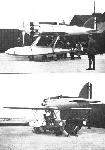
Short. Различные самолеты 1920-1932 годов
<...>
Совершенно другим оказался гоночный гидросамолет-моноплан Short-Bristol Crusader, построенный для участия в гонке на Кубок Шнайдера в 1927 году. К сожалению, при сборке тяг управления элеронами была допущена ошибка, и самолет потерпел аварию в Венеции.
<...>
Описание:
- Short. Различные самолеты 1920-1932 годов
- Flight, August 1927
THE 1927 SCHNEIDER TROPHY CONTEST
Фотографии
-
Aeroplane Monthly 1989-04 / A.Lumsden, T.Heffernan - Per Mare Probare (14)
Регистрационный номер: N226 [10] The Short-Bristow Crusader was relegated to practice flying at the 1927 contest at Venice. Painted gloss white overall with royal blue trim, the Crusader never carried its serial number N226.
-
Aeroplane Monthly 1989-04 / A.Lumsden, T.Heffernan - Per Mare Probare (14)
Регистрационный номер: N226 [10] View of the Short-Bristow Crusader. Its most marked characteristic was the large helmeted cylinder heads of the 860 h.p. Bristol Mercury nine-cylinder supercharged radial engine. The elliptical mainplanes were of biconvex RAF 27 aerofoil section.
-
Aeroplane Monthly 1989-04 / A.Lumsden, T.Heffernan - Per Mare Probare (14)
Регистрационный номер: N226 [10] -
Aviation Historian 1 / G.Warner - Why was the "Bristol" Mercury so long lived?
Регистрационный номер: N226 [10] The Short-Bristow Crusader was designed and built for the 1927 Schneider Trophy Race, Fedden realising that, unless he could make a compelling case for radial engines, liquid-cooled in-line engines - like those fitted to the rival Supermarine racers - would be seen as the only option for any future fighter designs.
-
Flight 1930-01 / Flight
Регистрационный номер: N226 [10] The Short "Crusader" (with Bristol racing "Mercury" engine) designed by Mr. Carter as a Schneider Trophy machine. The crossing of the aileron cables caused the machine to crash at Venice before it had a chance to show what it could do.
-
Flight 1927-08 / Flight
Регистрационный номер: N226 [10] THE AIR-COOLED CHALLENGER: Two views of the Short-Bristol "Crusader" mono-seaplane. Each of the nine cylinders of the Bristol "Mercury" air-cooled engine are streamlined by "helmets" - one of which is shown in situ.
-
Flight 1927-08 / Flight
Регистрационный номер: N226 [10] THE THIRD BRITISH SCHNEIDER CHALLENGER: Front view of the Short-Bristol "Crusader" mono-seaplane, which is fitted with a Bristol "Mercury" air-cooled radial engine.
-
Flight 1927-08 / Flight
Регистрационный номер: N226 [10] SOME OF THE "CRUSADERS": Reading from left to right - Maj. Abell (Bristol Co.); Mr. W. G. Carter (designer of the "Crusader"); Lieut-Col W.A.Bristow; Sq.-Ldr. Slatter (chief pilot of the team); Mr. Oswald Short (constructor of the machine); next to Mr. Short but obscured is Mr. Gouge, his chief designer; and two of the team, Flying Officers H. M. Schofield and T. H. Moon.
-
Flight 1927-08 / Flight
Регистрационный номер: N226 [10] The "Crusader's" Prime-Mover: The Crusader was fitted with a special racing version of the Jupiter, designated Mercury I, incorporating an ingenious helmeting system for the cylinders, which are seen here without all but the top streamline helmets.
-
Flight 1936-04 / Flight
Регистрационный номер: N226 [10] "Helmets" gave a good aerodynamic improvement, but bad cooling. The Short Crusader racing seaplane had its Bristol Mercury similarly cowled. Only one "helmet" is shown in place here.
- Фотографии









